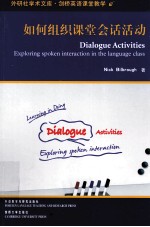

如何组织课堂会话活动PDF电子书下载
- 电子书积分:10 积分如何计算积分?
- 作 者:NICK BILBROUGH著
- 出 版 社:北京:外语教学与研究出版社;剑桥大学出版社
- 出版年份:2012
- ISBN:7560085296
- 页数:244 页
Introduction 1
1 Understanding 18
1.1 Understanding dialogues:a basic procedure 18
1.2 Boardgrab 21
1.3 Reading versus listening 23
1.4 Dialogue interpretation worksheets 24
1.5 Jigsaw 26
1.6 Designing exam questions 27
1.7 What are they talking about? 28
1.8 Snippets 29
1.9 Fairy tale tableaux 30
1.10 Lame jokes 31
1.11 Working with interviews 32
1.12 Dialogue as a way into a graded reader 35
1.13 The bit I like 37
2 Analysing 39
2.1 Tricky words 40
2.2 Closed mouth minimal pairs 40
2.3 Fishermen 42
2.4 Stage directions 45
2.5 Authentic versus scripted dialogues 47
2.6 Dialogue scan race 49
2.7 Filling in 53
2.8 Speech acts 55
2.9 The teacher does the speaking test 56
2.10 Student dialogue reformulation 57
2.11 Backchannelling 61
3 Reproducing and reconstructing 62
3.1 Jumbled lines 63
3.2 Dialogue rebuilding 65
3.3 The ultimate gapfill 68
3.4 Listen again 70
3.5 Jumbled reconstruction 71
3.6 Dialogue pairs 73
3.7 Dialogue retranslation 76
3.8 Retranslated tapescript 77
3.9 Dubbing 78
3.10 From monologue to dialogue 79
3.11 Turning news items into dialogue 81
3.12 Shadow dialogues 82
3.13 Mimed dialogues 84
3.14 Modernised voiceovers 86
3.15 Roughing up and censoring 89
4 Memorising 91
4.1 Who said what? 92
4.2 Reduced dialogues 93
4.3 Story to dialogue 95
4.4 Adjacency pair turnover cards 97
4.5 Remembering the questions 99
4.6 Dialogue halves 101
4.7 Line by line 103
4.8 Prompts 104
5 Rehearsing and performing 107
5.1 Chanted dialogue 108
5.2 Sounding like a gringo! 110
5.3 It's not what you say 112
5.4 Students perform the listening material 114
5.5 Improvising into a scene 115
5.6 Shadowing actors 117
5.7 Dialogues with movement 118
5.8 Who's next? 119
5.9 Conducted dialogue 121
5.10 Performance to writng 124
5.11 Reader's theatre 126
5.12 Direct speech 128
5.13 No way José 130
5.14 Let's have a drink 132
6 Co-constructing 134
6.1 By name and by nature 135
6.2 Half a conversation 137
6.3 Dialogue building 140
6.4 Community language learning 143
6.5 Writing dialogue articles 145
6.6 Famous last words 147
6.7 Dialogue into song 148
6.8 Conversational involvement 151
7 Creating and personalising 155
7.1 What did we have to say? 156
7.2 The words I'd like to own 157
7.3 Dice dialogues 158
7.4 Speech bubbles 159
7.5 Picture dialogues 160
7.6 Dark secret scenes 161
7.7 Soundtracks 163
7.8 Conscience alley 164
7.9 From depiction to dialogue 166
7.10 Semi-planned role-play 167
7.11 The room talks back 168
7.12 Into the future 169
8 Communicating 170
8.1 Venn diagrams 171
8.2 Speed dating 172
8.3 Gibberish scenes 174
8.4 Dialogue warm-ups 175
8.5 The status game 176
8.6 Cline debates 177
8.7 Gossip 178
8.8 Paper talk 180
8.9 Multi-speak dialogues 181
8.10 ABC dialogues 182
8.11 Odds versus evens 184
8.12 The yes/no game 185
8.13 Robinson Crusoe Island 185
8.14 Who's lying? 187
8.15 Interclass calls 189
8.16 Celebrity ball 192
8.17 Boring short stories 194
8.18 Read,turn and talk 195
9 Dialogue as Iearning 196
9.1 The closed question restaurant 197
9.2 Building a life 199
9.3 The dating agency 200
9.4 Talk and chalk 202
9.5 Never-ending dialogue 204
9.6 Would you give your teacher a job? 206
9.7 The tourists are coming 208
9.8 Dialogic text building 210
9.9 Cooperative storymaking 212
9.10 Teacherin role 213
9.11 Interrupting the tapescript 216
9.12 Dialogue versus internet 217
9.13 Difficult dialogues 220
Dialogue Bank A:From the film Mulholland Drive by David Lynch 222
Dialogue Bank B:Authentic snippets 226
Dialogue Bank C:Snippets from fairy tales 230
Dialogue Bank D:25 Lame jokes 232
Dialogue Bank E:Situational dialogues 234
Dialogue Bank F:Dating Agency(from the comedy series Little Britain) 237
Further reading and resources 239
Index 241
- 《课堂上听不到的历史传奇 世界政治军事名人 初中版》顾跃忠等编著 2015
- 《新课标背景下英语教学理论与教学活动研究》应丽君 2018
- 《幼儿英语游戏活动指导与实训》苏小菊,任晓琴主编;颜晓芳,覃静,谢恬恬,钟博维副主编 2020
- 《全国校外艺术课堂新形态示范教材系列 少儿钢琴表演曲集》唐冠祥编著 2019
- 《幼儿园创意美术主题活动方案 下学期》王燕媚 2017
- 《幼儿园区域活动新思考》黄玉娇,周霞编著 2019
- 《组织学与胚胎学习题集 第3版》周忠光主编;刘黎青,汪涛,李健副主编 2019
- 《学前儿童健康教育活动指导 第3版》麦少美,孙树珍主编;于海青,王劲松,刘雪梅编者 2019
- 《语文第二课堂 平凡的日子》曹文轩 2019
- 《语文第二课堂 未来的路上》曹文轩 2019
- 《中风偏瘫 脑萎缩 痴呆 最新治疗原则与方法》孙作东著 2004
- 《水面舰艇编队作战运筹分析》谭安胜著 2009
- 《王蒙文集 新版 35 评点《红楼梦》 上》王蒙著 2020
- 《TED说话的力量 世界优秀演讲者的口才秘诀》(坦桑)阿卡什·P.卡里亚著 2019
- 《燕堂夜话》蒋忠和著 2019
- 《经久》静水边著 2019
- 《魔法销售台词》(美)埃尔默·惠勒著 2019
- 《微表情密码》(波)卡西亚·韦佐夫斯基,(波)帕特里克·韦佐夫斯基著 2019
- 《看书琐记与作文秘诀》鲁迅著 2019
- 《酒国》莫言著 2019
